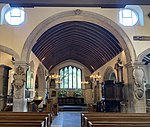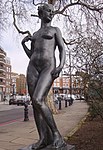Albion Riverside
Housing estates in the London Borough of WandsworthLondon building and structure stubs

Albion Riverside, in Battersea in London, is a high-end residential development located between Albert Bridge and Battersea Bridge on the River Thames. Completed in 2003 for client Hutchison Whampoa Property, it was designed by Foster and Partners in a high-tech modernist style to include an unusual asymmetrical crescent plan for the primary building with two independent rectilinear blocks to the west. The architect's own office, built in 1990, is immediately alongside to the east.
Excerpt from the Wikipedia article Albion Riverside (License: CC BY-SA 3.0, Authors, Images).Albion Riverside
Hester Road, London Battersea (London Borough of Wandsworth)
Geographical coordinates (GPS) Address Nearby Places Show on map
Geographical coordinates (GPS)
| Latitude | Longitude |
|---|---|
| N 51.480277777778 ° | E -0.16972222222222 ° |
Address
Albion Riverside
Hester Road
SW11 4AN London, Battersea (London Borough of Wandsworth)
England, United Kingdom
Open on Google Maps











